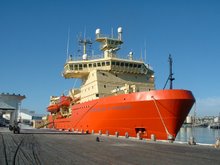Additionally, the best way to take CTD measurements is in a transect, so you can get a horizontal profile of the data. This involves moving from one location to another, and finishing up the collection of data before the next location is reached. Oh, did I mention that the water which we are sticking out hands in is COLD!!! My dexterity has been tested often so far, and although I'm improving, I still feel like a total klutz out there.
So we had our first real transect last night, in combination with a mooring removal and two mooring installations (a mooring is attached to the ocean floor to record data at various depths from the floor up to a specified depth (aside -- around here, you can't set moorings too shallow (say 300m or so) because icebergs will rip them off). Since Brice and I were not on our shifts yet, and we needed practice on our technique for sampling for CFC's and SF6, we both stayed up for the first CTD cast. Originally we thought it was going to happen at around 10, but we finished at 3. I woke up at 8 and they had just finished the 3rd cast. We're scheduled to do 3-4 more casts in this transect at depths ranging from 300-2000 meters. So shifts are a good idea. We'll start that soon, as we're doing a transect across the front of the entire Ross Ice Shelf (~2000 km) which will take a long time.
Seas are picking up but could be much worse. Last cruise, the NBP was hit with a 40 foot wave right around here -- a metal container (think garbage truck size) was completely caved in by the wave. here's the outlook:
EXPECT WINDS SE 10-15 KTS, INCREASING TO SE 25-30 KTS AT 060000Z, FURTHER INCREASING TO SE 35-45 KTS AT 060900Z. COMBINED SEAS SE 6-8 FT AT 051200Z, INCREASING TO SE 17-21 FT AT 061200Z.//
yee-haw!
C


No comments:
Post a Comment